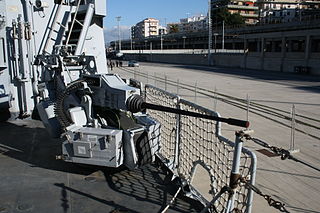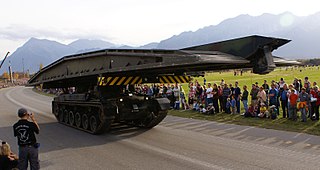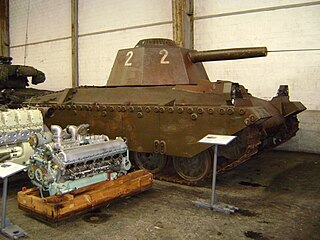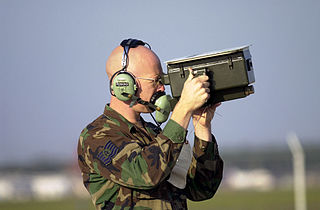
The Rooikat is a South African armoured reconnaissance vehicle equipped with a stabilised 76mm high velocity gun for organic anti-tank and fire support purposes. It is capable of giving the same performance and using the same ammunition as the Oto Melara 76 naval gun, albeit with new percussion primers.
Rheinmetall AG is a European defence contractor. Rheinmetall has a presence in two corporate sectors with six divisions, and is headquartered in Düsseldorf, Germany. In fiscal 2018, the company generated sales of €6.148 billion.

The ZSU-57-2 Ob'yekt 500 is a Soviet self-propelled anti-aircraft gun (SPAAG), armed with two 57 mm autocannons. 'ZSU' stands for Zenitnaya Samokhodnaya Ustanovka, meaning "anti-aircraft self-propelled mount", '57' stands for the bore of the armament in millimetres and '2' stands for the number of gun barrels. It was the first Soviet mass-produced tracked SPAAG. In the USSR it had the unofficial nickname "Sparka", meaning "twin mount", referring to the twin autocannon with which the vehicle is armed.

The PZA Loara is a Polish armored radar-directed self-propelled anti-aircraft gun system. The original PZA Loara prototype was based on the chassis of the T-72M tank. The production version known as PZA Loara-A is based on the chassis of the PT-91 MBT.

The Oerlikon GDF or Oerlikon 35 mm twin cannon is a towed anti-aircraft gun made by Oerlikon Contraves. The system was originally designated as 2 ZLA/353 ML but this was later changed to GDF-001. It was developed in the late 1950s and is used by around 30 countries.

The Heuschrecke 10 was a German prototype self-propelled gun and Waffenträger developed by Krupp-Gruson between 1943 and 1944. The official designation of the vehicle was 105 mm leichte Feldhaubitze 18/1 L/28 auf Waffenträger Geschützwagen IVb and was to be built in Magdeburg, Germany. The Heuschrecke featured a removable turret which could be deployed as a pillbox or towed behind the vehicle as an artillery piece.

The Panzer 61 was a Swiss Cold War era medium tank later reclassified as a second-generation main battle tank. The tank had a weight of 36.5 tons and was powered by a 630 hp diesel engine, which gave it a top road speed of 50 km/h (31 mph). The primary armament of the Panzer 61 was a 105 mm main gun.

The Panzer 68 was a Swiss main battle tank developed by the Eidgenoessische Konstruktionswerkstaette in Thun in the late 1960s.

The Denel 35mm Dual Purpose Gun (35DPG) is a close-in weapon system (CIWS) for warships built in South Africa by Denel Land Systems. It is currently in service on the Valour class frigates of the South African Navy.

The ZSU-23-4 "Shilka" is a lightly armored Soviet self-propelled, radar guided anti-aircraft weapon system (SPAAG).

The Oerlikon KBA is a 25 mm (25×137mm) cannon, developed as a close range weapon for the mechanized battlefield originally made by Oerlikon Contraves AG.

The MOWAG Shark is an armored personnel carrier produced by the MOWAG Motor Car Factory, Kreuzlingen, Switzerland.

The Entpannungspanzer 65 is a Swiss armored recovery vehicle developed by Eidgenoessische Konstruktionswerkstaette Thun in the late 1960s. The vehicle served as a traveling workshop for the Swiss military.

The Brückenpanzer 68 is an armoured vehicle-launched bridge manufactured by the Eidgenoessische Konstruktionswerkstaette, which was used by the Swiss Army. It is the bridge-laying version of the Panzer 68 tank.

The Target tank 68 was a decommissioned Panzer 68, which was converted to the target vehicle role. A total of ten of these vehicles were in use.

Nahkampfkanone 2 is a tank destroyer prototype of Swiss design.

The RSA is one of the earliest surface-to-air missiles systems, developed by the Swiss companies Oerlikon-Bührle and Contraves starting in 1947. The missile went through a rapid development process with several upgraded versions, and was the first anti-aircraft missile offered for commercial sale when it was placed on the market in the RSC-50 form. The US tested 25 of the slightly different RSC-51 model under the name MX-1868. No further sales were forthcoming. Several improved versions followed, including the RSC-54, RSC-56, RSC-57 and RSC/RSD-58. These saw small numbers of sales, mostly as training rounds.

The Mittlerer Panzer 1958 or Panzer 58 was a medium tank of Swiss design. Twelve tanks were produced and later converted to Panzer 61s.

The Schweizerisches Militärmuseum Full is the Swiss military museum, located in Full-Reuenthal, canton Aargau.
The 'Panzer 2000' was a Swiss tank destined to replace the Panzer 68 from the Swiss Confederation of Construction). But it remained only a project, instead of the Swiss Army, the German Panzer Leopard 2 was procured.





















